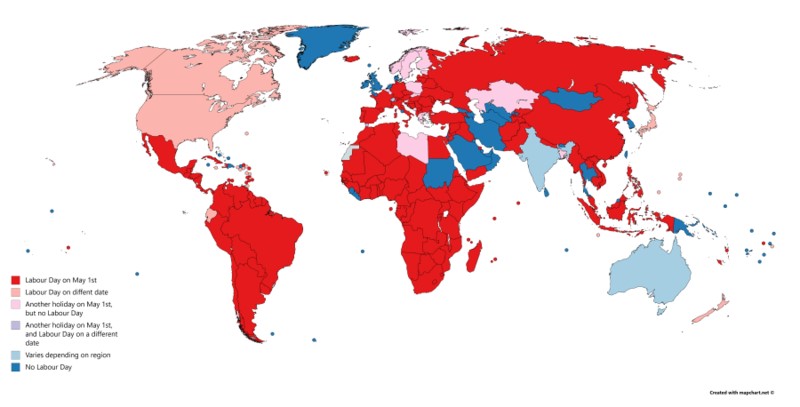
Monday, Sept. 5, is Labor Day – a day set aside for honoring and celebrating the struggles and achievements workers and their unions have made, and continue to make, in turning the American economy into the world powerhouse it is today. While we tend to think about Labor Day as a uniquely American holiday, the truth is that almost from the outset of when either McGuire or Maguire (depending on which story you believe) proposed the first Labor Day, the idea of a day for honoring working people has held international appeal.
The first American Labor Day was celebrated on Sept. 5, 1882, in New York City. Less than seven years later, Labor Day went global. In 1889, an international federation of socialists and trade unions in Europe decided to create a similar holiday: International Workers’ Day (or Labour Day) to be celebrated on May 1 of each year, a tradition that continues to this day in more than 60 countries.
Many of us in the United States think about International Workers’ Day as a European celebration. But there is a uniquely American connection that we should all remember on our own Labor Day. The international federation picked that date to commemorate a general strike in Chicago called on May 1, 1886, with tens of thousands of American workers fighting for a right we’ve come to enjoy as standard: the eight-hour workday. The strike, however, met with tragedy just a few days later. On May 4, a riot broke out in Chicago when police attempted to clear Haymarket Square of strikers, leaving seven police officers and four civilians dead, with dozens of others wounded. Eight men were convicted of the killings and sentenced to death following a shamefully unjust trial. The next Illinois governor pardoned the three strikers, who had not yet been executed, six years after their conviction.
While the Haymarket Affair is a painful reminder of the oppressive working conditions that marked the late 19th and early 20th-century workplace, it is also the symbol of the struggle of workers that led to the establishment of an important day of remembrance and a continued call to action. International Workers’ Day, Labour Day and Labor Day give voice to working people who too often work without one. It is a day that should remind us of the work achieved by unions and others to secure a better life for all, while at the same time reminding us of the work that remains to be done. Even acknowledging our advances since 1882, workers in the United States still lag far behind their European counterparts in healthcare coverage, paid leave and retirement protection. And over the last 55 years, the gap between the average CEO compensation package and the average workers’ wage has risen from 21-to-1 in 1965 to 351-to-1 in 2020. In 2022, for the top 300 U.S. firms, the ratio was an even more abysmal contrast of 670-to-1.
Admittedly, the September holiday here in the U.S. has become largely associated with the start of a new school year, the unofficial end of summer, and countless sales from retailers. But that is not the case for much of the world, where Labour Day is a day of demonstrations, protests and memorials. Perhaps there are lessons we should learn from Labor Day’s sibling holidays.
In much of the world, Labour Day also gets a bit of a boost by sharing the date with other celebrations. In much of Europe, May 1 is also May Day, a traditional festival of springtime and renewal involving singing, dancing, fairs, and plenty of other entertainment that naturally brings people together in public venues, making it easy for wide dissemination of the public speeches and remembrances more substantively associated with Labour Day. Japan actually observes its Labor Day on the same day as Thanksgiving. Every November 23, the people of Japan celebrate Labor Thanksgiving Day, an occasion to respect labor, to celebrate production, and for citizens to give each other thanks for their hard work. It could arguably be considered a triple holiday: Like Europe, the date coincides with an ancient festival, though instead of spring and renewal, the Japanese holiday of niinamesai is for the harvest season.
The most important lesson to take from the prevalence and prominence of Labor Day is that celebrating working people is a nearly universal observance that crosses all borders and enriches the human experience. While people celebrate at different times and with breathtaking diversity, the day nonetheless stands as a unifying occasion we can all recognize and cherish. So this Labor Day, on the way to a final beach trip, or perhaps before you make that big- ticket purchase or throw burgers on the grill, take a moment to think about the history surrounding Labor Day, listen to a podcast on Labor Day, or just generally consider the role that rank-and-file workers play in keeping our country and our world the productive and magnificent marvel it truly is.
Jeffrey Freund is the director of the U.S. Department of Labor’s Office of Labor-Management Standards.

 U.S. Department of Labor Blog
U.S. Department of Labor Blog
